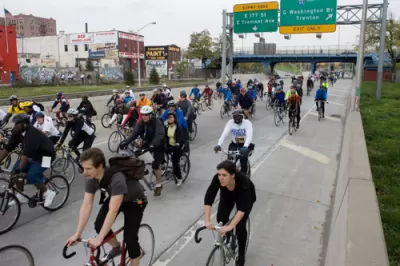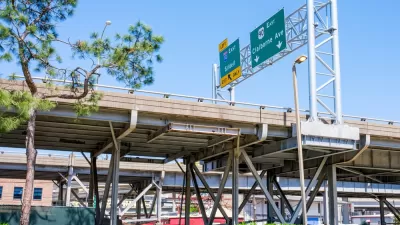Transportation Secretary Anthony Foxx sees rebuilding America's ailing infrastructure as an opportunity to "right past wrongs," particularly with 1950s and 1960s-era freeways that bisected communities. NPR and Streetsblog describe the new initiative.

Secretary Foxx tells NPR correspondent Brian Naylor how two interstate highways separated his childhood neighborhood in North Carolina.
"I didn't realize it as a kid; I didn't think about it as economic and psychological barriers but they were and the choices of where that infrastructure was placed in my community were not unique to Charlotte."
Naylor then turns to the legacy of controversial New York urban planner Robert Moses, "notorious for tearing up communities in the interests of the car, opposition be damned." Archival audio of Moses follows:
"Raw, categorical imperative is action to clear the slums and we can't let minorities dictate that this century-old chore will be put off another generation or finally abandoned," states Moses.
"Foxx says the highway barriers created by Moses and others were the result of deliberate decisions to route them through low income neighborhoods," states Naylor. "Now, decades later as infrastructure needs replacing or repairing, Foxx says there's an opportunity."
Naylor then turns to the Hunts Point section of the South Bronx, "a gritty neighborhood ringed by waste transfer stations...," where trucks pose "a constant threat on the local streets."
He interviews two community activists who describe the neighborhood division resulting from the Sheridan Expressway, an underused, 1.25-mile long stub built by Moses in 1963, that separates the community from an underused neighborhood park.
A 2010 post states that the expressway "has become a [national] battleground in a fight to take urban spaces back from the automobile."
Years of activism have paid off, states Naylor. Earlier in April the State of New York approved spending $97 million to convert the Sheridan Expressway into a boulevard "with crosswalks and bike paths."
On March 30, Streetsblog USA's Angie Schmitt wrote about the secretary's presentation to the Center for American Progress on the new initiative, called Ladders of Opportunity, "which aims to shape transportation policy based on how infrastructure can serve as a barrier, or bridge, to jobs, education, and better health."
The disparities go beyond highway planning. “Look at our basic sidewalk infrastructure,” Foxx said, pointing to a photo of the notorious Buford Highway in suburban Atlanta. “You see these roads are really designed for cars, not people. There are no sidewalks, and where you see sidewalks there are no crosswalks.”
A short (2:43-minute) video, "Bridging the Divide: Connecting People to Opportunity," is on the U.S. DOT webpage, Ladders of Opportunity.
Hat tips to Chuck Siegel and Larry Fox.
FULL STORY: Secretary Foxx Pushes To Make Transportation Projects More Inclusive

Maui's Vacation Rental Debate Turns Ugly
Verbal attacks, misinformation campaigns and fistfights plague a high-stakes debate to convert thousands of vacation rentals into long-term housing.

Planetizen Federal Action Tracker
A weekly monitor of how Trump’s orders and actions are impacting planners and planning in America.

San Francisco Suspends Traffic Calming Amidst Record Deaths
Citing “a challenging fiscal landscape,” the city will cease the program on the heels of 42 traffic deaths, including 24 pedestrians.

Defunct Pittsburgh Power Plant to Become Residential Tower
A decommissioned steam heat plant will be redeveloped into almost 100 affordable housing units.

Trump Prompts Restructuring of Transportation Research Board in “Unprecedented Overreach”
The TRB has eliminated more than half of its committees including those focused on climate, equity, and cities.

Amtrak Rolls Out New Orleans to Alabama “Mardi Gras” Train
The new service will operate morning and evening departures between Mobile and New Orleans.
Urban Design for Planners 1: Software Tools
This six-course series explores essential urban design concepts using open source software and equips planners with the tools they need to participate fully in the urban design process.
Planning for Universal Design
Learn the tools for implementing Universal Design in planning regulations.
Heyer Gruel & Associates PA
JM Goldson LLC
Custer County Colorado
City of Camden Redevelopment Agency
City of Astoria
Transportation Research & Education Center (TREC) at Portland State University
Jefferson Parish Government
Camden Redevelopment Agency
City of Claremont




























